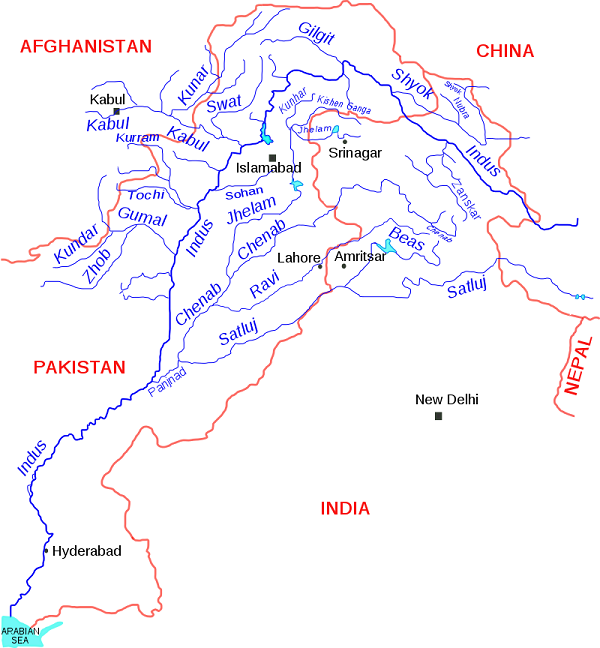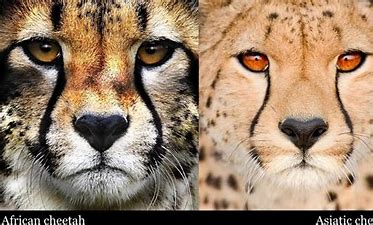CONTENT
- Indus Waters Treaty
- Cheetah
- Ramcharitmanas of Tulsidas
- Monument Mitra Scheme
Indus Waters Treaty
Context:
Recently, India announced that it wants to modify the 62-year-old Indus Waters Treaty (IWT) with Pakistan, citing what it called Pakistan’s “intransigence” in resolving disputes over the Kishenganga and Ratle hydropower projects, both in Jammu and Kashmir.

Relevance:
GS-II: International Relations (India and its Neighborhood, International Treaties, Policies and Agreements affecting India’s Interests)
Dimensions of the Article:
- About the Indus Waters Treaty (IWT)
- Indus River Basin
About the Indus Waters Treaty (IWT)

- The Indus Waters Treaty is a water-distribution treaty between India and Pakistan, brokered by the World Bank, to use the water available in the Indus River and its tributaries.
- The Indus Waters Treaty (IWT) was signed in Karachi in 1960.
- The Treaty gives control over the waters of the three “eastern rivers” — the Beas, Ravi and Sutlej to India, while control over the waters of the three “western rivers” — the Indus, Chenab and Jhelum to Pakistan.
- India was allocated about 16% of the total water carried by the Indus system while Pakistan was allocated the remainder.
- The treaty allows India to use the Western River waters (the ones in Pakistan’s control) for limited irrigation use and unlimited non-consumptive use for such applications as power generation, navigation, floating of property, fish culture, etc.
- It lays down detailed regulations for India in building projects over the western rivers.
- The preamble of the treaty recognises the rights and obligations of each country in the optimum use of water from the Indus system in a spirit of goodwill, friendship and cooperation.
Indus River Basin

- The Indus River (also called the Sindhū) is one of the longest rivers in Asia and the longest river of Pakistan.
- It flows through China (western Tibet), India (Ladakh) and Pakistan.
- Its estimated annual flow is estimated to be twice that of the Nile River making it one of the largest rivers in the world in terms of annual flow.
- The Zanskar river is its left bank tributary in Ladakh.
- In the plains, its left bank tributary is the Panjnad which itself has five major tributaries, namely, the Chenab, Jhelum, the Ravi, the Beas, and the Sutlej.
- Its principal right bank tributaries are the Shyok, the Gilgit, the Kabul, the Gomal, and the Kurram.
-Source: The Hindu
Cheetah
Context:
Recently, India and South Africa have finally signed a long-pending agreement to translocate 12 cheetahs to India.
- The cheetahs will be transported to India by February-end and reintroduced at the Kuno National Park in Madhya Pradesh, where eight such cats were brought from Namibia in September last year under a similar agreement.
Relevance:
GS III: Environment and Ecology
Dimensions of the Article:
- What caused the extinction of cheetahs in India?
- Why is the cheetah being brought back?
- How was Kuno National Park chosen for the translocation?
- What are the future plans to increase cheetah population in India?
- About Cheetah
What caused the extinction of cheetahs in India?
- The cheetah in India has been recorded in history from before the Common Era. It was taken from the wild for coursing blackbuck for centuries, which is a major contributor to the depletion of its numbers through the ages.
- However, the final phase of its extinction coincided with British colonial rule. The British added to the woes of the species by declaring a bounty for killing it in 1871.
- Major reasons for the extinction of the Asiatic cheetah in India.
- The consistent and widespread capture of cheetahs from the wild (both male and female) over centuries
- Its reduced levels of genetic heterogeneity due to a historical genetic bottleneck resulting in reduced fecundity and high infant mortality in the wild.
- Its inability to breed in captivity.
- Sport hunting.
- Bounty killings.
- It is reported that the Mughal Emperor Akbar had kept 1,000 cheetahs in his menagerie and collected as many as 9,000 cats during his half century reign from 1556 to 1605.
- As late as 1799, Tipu Sultan of Mysore is reported to have had 16 cheetahs as part of his menagerie.
- It is recorded that the last cheetahs were shot in India in 1947, but there are credible reports of sightings of the cat till about 1967.
Why is the cheetah being brought back?
- The aim behind the translocation is not only to restore India’s ‘historic evolutionary balance’, but also to develop a cheetah ‘metapopulation’ that will help in the global conservation of the animal.
- While attempts to relocate cheetahs to India began in 2009, it was only in 2020 that the Supreme Court of India finally gave the green signal for such efforts.
- As it is a flagship species, the conservation of the cheetah will revive grassland-forests and its biome and habitat, much like Project Tiger has done for forests and all the species found in these forests.
- Project Tiger has also resulted in the conservation of 250 water bodies found in India’s 52 Tiger Reserves.
- The Cheetah Project is likely to have a similar impact.
- The translocation project has also helped conservation efforts in Africa, in particular South Africa.
South African cheetah:
- The South African cheetah population had dwindled two decades ago, before the conservation programme ensured that the numbers increased – of the global cheetah population of 7,000, 4,500 belong to South Africa.
- The cheetah is believed to have originated in South Africa and spread across the world through land connectivity.
- In the Kalahari, the cheetah was once critically endangered due to poaching and hunting. But now, with healthy female cheetahs producing five to six cubs each, South Africa is rapidly running out of space for its cheetah population.
How was Kuno National Park chosen for the translocation?
Lion relocation project
- Six sites, which had been previously assessed in 2010 for the translocation of the Asiatic Lion, were re-assessed by WII in 2020.
- Of these six sites, Kuno, which had been monitored since 2006, was found to be ready to receive the cheetah immediately, as it had already been prepared for the Asiatic Lion. Both animals share the same habitat – semi-arid grasslands and forests that stretch across Gujarat, Rajasthan and Madhya Pradesh.
- The upgradation of sites required investment on a large scale in terms of reducing anthropogenic pressures through relocation of villages, mitigating infrastructure (roadways and railway) and prey augmentation for the cheetah through translocation of blackbuck, chital, chinkara and wild boar, among other animals.
- In Kuno National Park, because of the lion relocation project, the Madhya Pradesh Forest Department had already relocated 24 of the 25 villages and declared it a national park, which led to “remarkable recovery in its habitat, prey abundance and reduction of human impact”, according to the assessment carried out by WII in 2020.
- Only one village – Bagcha, with a population of 148 – remains on the fringes of the forest.
Climatic conditions
- In Sheopur district, where Kuno is located, rainfall levels, temperatures, altitude, and conditions are similar to conditions in both South Africa and Namibia.
- The leopard and striped hyena are currently the only larger carnivores within the national park, the single lone tiger having returned to Ranthambore in 2019-20.
What are the future plans to increase cheetah population in India?
- Over the coming 15 years, the Indian government will acquire two to four cheetahs from Africa, with the process undertaken at an interval of one to four years, to establish a breeding cheetah metapopulation of 35-40 in the country.
- Once the population in Kuno National Park has adapted and is flourishing, the Indian government will expand the efforts to reserves in other parts of the country as well.
- Cheetah can also live in a wide range of habitats, which includes the most prominent semi-arid grassland, but also coastal scrubs, wooded savannah, Montane habitat, snow deserts and rugged semi-arid areas.
About Cheetah:

- The cheetah is one of the oldest of the big cat species, with ancestors that can be traced back more than five million years to the Miocene era.
- The cheetah is also the world’s fastest land mammal that lives in Africa and Asia.
African Cheetah
- IUCN status – Vulnerable
- CITES status – Appendix-I of the List. This List comprises of migratory species that have been assessed as being in danger of extinction throughout all or a significant portion of their range.
- Habitat – Around 6,500-7,000 African cheetahs present in the wild.
- Physical Characteristics – Bigger in size as compared to Asiatic Cheetah.
Asian Cheetah
- IUCN Status – Critically Endangered.
- CITES – Appendix 1 of the list
- Habitat – 40-50 found only in Iran.
- Physical Characteristics – Smaller and paler than the African cheetah. Has more fur, a smaller head and a longer neck. Usually have red eyes and they have a more cat-like appearance.
-Source: Indian Express
Ramcharitmanas of Tulsidas
Context:
Recently, Bihar Education Minister said the Ramcharitmanas “spreads hatred in society”, and that Goswami Tulsidas’s epic poem — along with the Manusmriti and M S Golwalkar’s Bunch of Thoughts — should be burned.
Relevance:
GS I: History
Dimensions of the Article:
- The Ramcharitmanas
- Goswami Tulsidas
The Ramcharitmanas
- The poem was written in the 16th century in the Awadhi dialect that is mainly spoken in the areas that are today’s Lucknow, Prayagraj, and Ayodhya districts.
- It is divided into seven chapters (Kand) that tell the story of Lord Ram from birth to his becoming King of Ayodhya.
- The Ramcharitmanas is based on the Ramayana, sage Valmiki’s great epic.
- It is the holiest book of the Indo-Gangetic region, and among the world’s most read holy books — by one estimate, Geeta Press (Gorakhpur) has sold almost 7 crore copies.
- Across the Hindi heartland, a reference to “Ramayan” often actually means Ramcharitmanas.
Goswami Tulsidas
- Tulsidas, a Brahmin whose original name was Ram Bola Dubey, is believed to have been born in Rajapur by the Yamuna in today’s Banda district.
- He composed the Ramcharitmanas on the bank of the Ganga in Varanasi — he is said to have begun writing on Ram Navami day in 1574, and completed the poem over the next few years.
- In the seventh shloka of the first chapter (Baal Kand), Tulsidas declares, “Swantah sukhay Tulsi Raghunathgatha…” — that is, he has written the “story of Raghunath (Lord Ram) for his own happiness”.
- Tulsidas lived in the time of Emperor Akbar, and some believe that he was in touch with Abdurrahim Khan-e-Khanan, the son of Akbar’s commander Bairam Khan, and they possibly exchanged some poetic communication as well.
- Tulsidas made the story of Lord Ram popular among the masses because he wrote in the regional dialect that most people understood.
-Source: Indian Express
Monument Mitra Scheme
Context:
The Secretary of the Ministry of Culture recently said that the government will hand over around 1,000 monuments under the control of the Archaeological Survey of India to the private sector for their upkeep under the Monument Mitra Scheme.
Relevance:
GS II: Government schemes
About Monument Mitra Scheme:
- Nodal Ministry: Ministry of Culture in respect of the monuments under the Archaeological Survey of India.
- It applies to all centrally protected heritage properties.
- Aim: Ensuring quality & inclusive provision of amenities and facilities across heritage, natural, & tourist sites through the active participation of private and public sector organizations and individuals.
- Corporate entities will take over these monuments as part of their Corporate Social Responsibility.
- These organizations would be known as “Monument Mitras”for their collaboration initiative.
- The government has set the target to hand over 500 sites under the revamped Monument Mitra Scheme by the end of Azadi ka Amrit Mahotsav on 15 August 2023.
-Source: Indian Express



